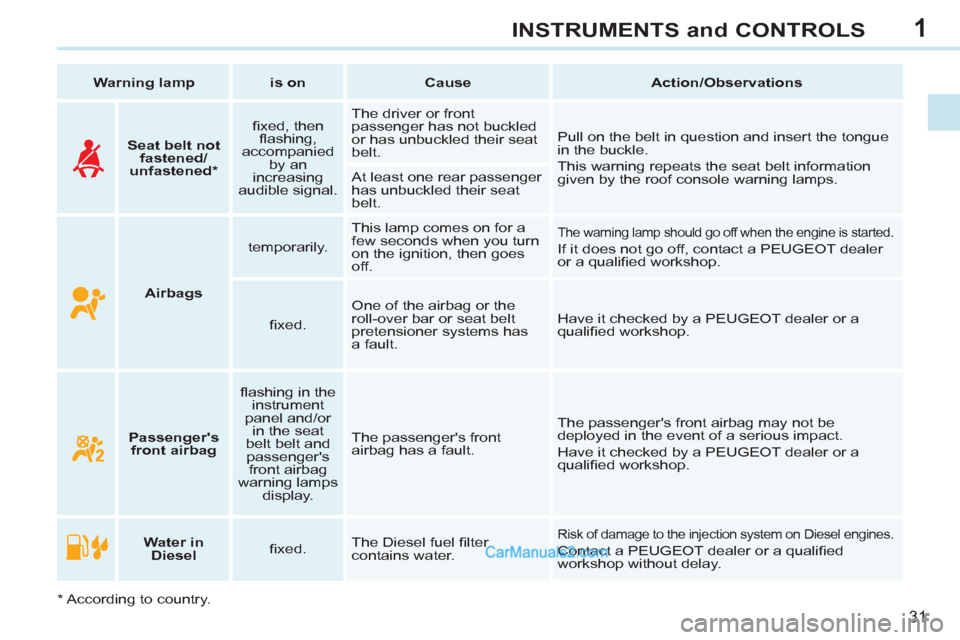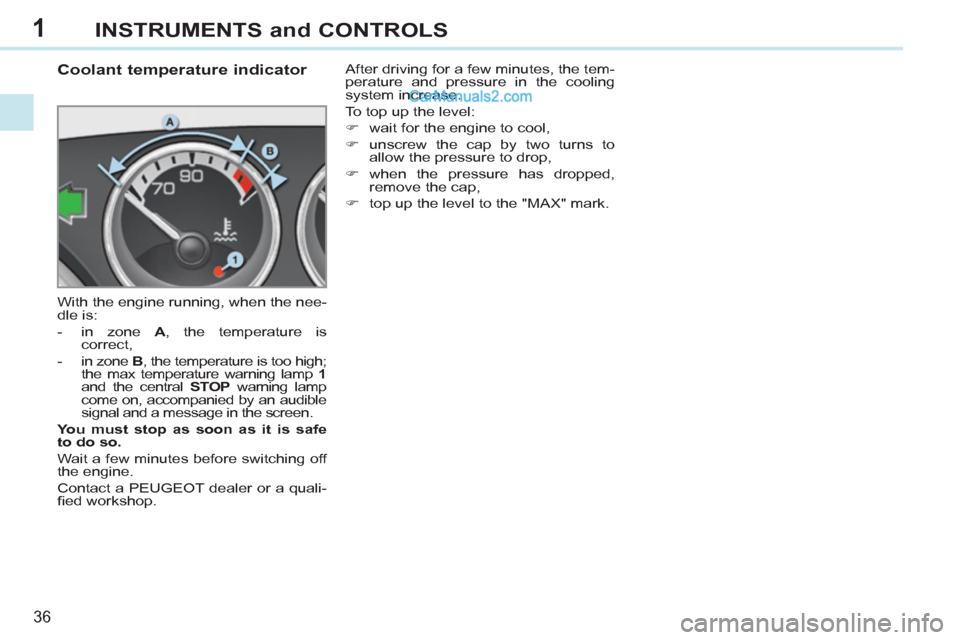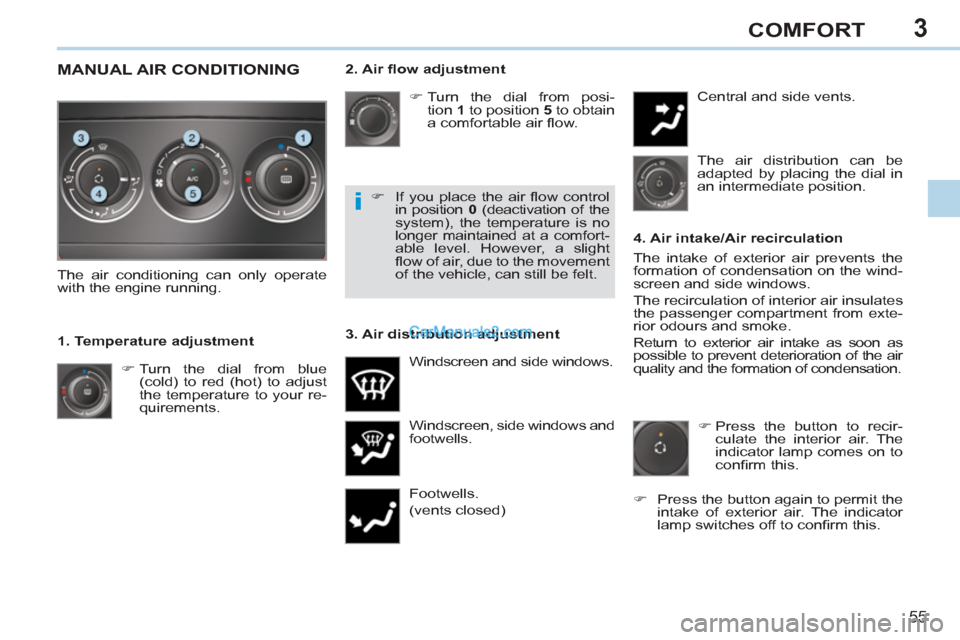2011 Peugeot 308 CC engine
[x] Cancel search: enginePage 33 of 292

1
31
INSTRUMENTS and CONTROLS
Warning lamp
is on
Cause
Action/Observations
Water in
Diesel
fi xed. The Diesel fuel fi lter
contains water.
Risk of damage to the injection system on Diesel engines.
Contact a PEUGEOT dealer or a qualifi ed
workshop without delay.
Airbags
temporarily. This lamp comes on for a
few seconds when you turn
on the ignition, then goes
off.
The warning lamp should go off when the engine is started.
If it does not go off, contact a PEUGEOT dealer
or a qualifi ed workshop.
fi xed. One of the airbag or the
roll-over bar or seat belt
pretensioner systems has
a fault. Have it checked by a PEUGEOT dealer or a
qualifi ed workshop.
Seat belt not
fastened/
unfastened *
fi xed, then
fl ashing,
accompanied
by an
increasing
audible signal. The driver or front
passenger has not buckled
or has unbuckled their seat
belt. Pull on the belt in question and insert the tongue
in the buckle.
This warning repeats the seat belt information
given by the roof console warning lamps. At least one rear passenger
has unbuckled their seat
belt.
*
According to country.
Passenger's
front airbag
fl ashing in the
instrument
panel and/or
in the seat
belt belt and
passenger's
front airbag
warning lamps
display. The passenger's front
airbag has a fault. The passenger's front airbag may not be
deployed in the event of a serious impact.
Have it checked by a PEUGEOT dealer or a
qualifi ed workshop.
Page 35 of 292

1
33
INSTRUMENTS and CONTROLS
Warning lamp
is on
Cause
Action/Observations
Front
foglamps
fi xed. The front foglamps are
switched on. Turn the ring on the stalk rearwards twice to
switch off the front foglamps.
Rear
foglamps
fi xed. The rear foglamps are
switched on. Turn the ring on the stalk rearwards to switch off
the rear foglamps.
Diesel engine
pre-heating
fi xed. The ignition switch is at the
2nd position (ignition on).
Wait until the warning lamp has switched off before starting.
The duration for which the warning lamp is on is
determined by the climatic conditions.
Stop & Start
fi xed. When the vehicle stops (red
lights, traffi c jams, ...) the
Stop & Start system has
put the engine into STOP
mode. The warning lamp goes off and the engine
restarts automatically in START mode, as soon
as you want to move off.
fl ashes for a
few seconds,
then goes off. STOP mode is temporarily
unavailable.
or
START mode is invoked
automatically. Refer to "Driving - § Stop & Start" for special
cases with STOP mode and START mode.
Dipped beam
headlamps
fi xed. The lighting stalk is in the
"Dipped beam headlamps"
position or in the "AUTO"
position in conditions of low
light.
Main beam
headlamps
fi xed. The lighting stalk is pulled
towards you. Pull the stalk again to return to dipped beam
headlamps.
Page 37 of 292

1
35
INSTRUMENTS and CONTROLS
Warning lamp
is on
Cause
Action/Observations
Deactivation warning lamps
If one of the following warning lamps comes on, this confi rms that the corresponding system has been switched off intentionally.
This may be accompanied by an audible signal.
Depending on your version of instrument panel, illumination of the warning lamp is also accompanied by:
Passenger's
front airbag
fi xed in the
instrument
panel and/or
in the seat
belt and front
passenger's
airbag warning
lamps display. The control switch, located on the
passenger's end of the dashboard, is
set to the "OFF"
position.
The passenger's front airbag is
deactivated.
You can install a rear-facing child seat
on the front passenger seat. To activate the front passenger's
airbag, set the switch to the "ON"
position; in this case, it is not possible
to fi t a child seat in the rear-facing
position on this seat.
ESP/ASR
fi xed. The button, located in the middle of
the dashboard, is pressed. Its indicator
lamp is on.
The ESP/ASR is deactivated. The
following functions are deactivated:
- ESP (dynamic stability control),
- ASR (wheel anti-slip regulation).
Press the button again to manually reactivate
these functions. Its indicator lamp goes off.
From approximately 30 mph (50 km/h), these
systems are reactivated automatically (except
for the 1.6 litre THP 200 hp petrol engine).
These function are activated automatically
when the vehicle is started.
- a message in the multifunction
screen, or
- a pictogram in the central instrument
panel screen and a message in the
multifunction screen, or
- a pictogram and a message in the
central instrument panel screen.
Page 38 of 292

1
36
INSTRUMENTS and CONTROLS
Coolant temperature indicator
With the engine running, when the nee-
dle is:
- in zone A
, the temperature is
correct,
- in zone B
, the temperature is too high;
the max temperature warning lamp 1
and the central STOP
warning lamp
come on, accompanied by an audible
signal and a message in the screen.
You must stop as soon as it is safe
to do so.
Wait a few minutes before switching off
the engine.
Contact a PEUGEOT dealer or a quali-
fi ed workshop. After driving for a few minutes, the tem-
perature and pressure in the cooling
system increase.
To top up the level:
�)
wait for the engine to cool,
�)
unscrew the cap by two turns to
allow the pressure to drop,
�)
when the pressure has dropped,
remove the cap,
�)
top up the level to the "MAX" mark.
Page 39 of 292

1
i
37
INSTRUMENTS and CONTROLS
The level shown will only be correct
if the vehicle is on level ground and
the engine has been off for more
than 30 minutes.
Engine oil level indicator
System which informs the driver wheth-
er the engine oil level is correct or not. This information is indicated for a few
seconds when the ignition is switched
on, after the service information.
Oil level correct
Oil level low
Oil level indicator fault
Dipstick
This is indicated by the fl ashing of
"OIL"
, linked with the service warning
lamp, accompanied by an audible sig-
nal and a message in the multifunction
screen.
If the low oil level is confi rmed by a
check using the dipstick, the level must
be topped up to prevent damage to the
engine. This is indicated by the fl ashing of
"OIL --"
. Contact a PEUGEOT dealer or
a qualifi ed workshop.
Refer to the "Checks" section to locate
the dipstick and the oil fi ller cap on your
engine.
There are 2 marks on the
dipstick:
- A
= max; never exceed
this level (risk of
damage to the engine),
- B
= min; top up the
level via the oil fi ller
cap, using the grade
of oil suited to your
engine.
Page 42 of 292

1
40
INSTRUMENTS and CONTROLS
Manual Check
This function allows you to check the sta-
tus of the vehicle (reminder of the alert
warnings and of the state of the confi gu-
rable functions - "activated" or "deacti-
vated") and the service information.
�)
With the engine running, to start
a manual check, briefl y press
the "CHECK/000"
button on the
instrument panel. If no faults have been detected,
"CHECK OK"
appears in the instru-
ment panel central screen.
If a "minor" fault has been detected, the
warning lamp concerned then "CHECK
OK"
appear in the instrument panel
central screen. Contact a PEUGEOT or
a qualifi ed workshop.
If a "major" fault has been detected, only
the warning lamps concerned appear
in the instrument panel central screen.
Have it checked by a PEUGEOT dealer
or a qualifi ed workshop.
Distance recorders
The total and trip distances are displayed
for thirty seconds when the ignition is
switched off, when the driver's door is
opened and when the vehicle is locked
or unlocked.
Total distance recorder
Measures the total distance travelled by
the vehicle since its fi rst registration.
�)
With the ignition on, press and hold
this button until zeros appear.
Trip distance recorder
Measures a distance travelled since it
was reset to zero by the driver.
Page 56 of 292

3
i
i
54
COMFORT
The condensation created by the
air conditioning results in a dis-
charge of water under the vehicle
which is perfectly normal.
RECOMMENDATIONS FOR VENTILATION AND AIR
CONDITIONING
In order for these systems to be fully effective, follow the guidelines on
operation and maintenance below:
�)
To obtain an even air distribution, take care not to obstruct the exterior air
intake grilles located at the base of the windscreen, the nozzles, the vents
and the air outlets, as well as the air extractor located in the boot.
�)
Do not cover the sunshine sensor, located on the dashboard; this is used
for regulation of the air conditioning system.
�)
Operate the air conditioning system for 5 to 10 minutes, once or twice a
month to keep it in perfect working order.
�)
Ensure that the passenger compartment fi lter is in good condition and
have the fi lter elements replaced regularly (refer to the "Checks" section).
�)
We recommend the use of a combined passenger compartment fi lter. Thanks
to its second special active fi lter, it contributes to the purifi cation of the air
breathed by the occupants and the cleanness of the passenger compartment
(reduction of allergic symptoms, bad odours and greasy deposits).
�)
To guarantee correct operation of the air conditioning system, you are also
advised to have it checked regularly.
�)
If the system does not produce cold air, do not use it and contact a
PEUGEOT dealer or a qualifi ed workshop.
In the "cabriolet" confi guration, installing the windstop and using the "AIRWAVE"
systems improves comfort.
When towing the maximum load on a steep gradient in high temperatures,
switching off the air conditioning permits the recovery of engine power and
therefore improvement of the towing capacity.
If the interior temperature remains
very high after the vehicle has been
parked in the sun for a considerable
time, fi rst ventilate the passenger
compartment for a few minutes.
Place the air fl ow control at a suf-
fi cient level to provide an adequate
renewal of air in the passenger
compartment.
The air conditioning system does
not contain chlorine and does not
present any danger to the ozone
layer.
Stop & Start
The heating and air conditioning systems only work when the engine is running.
To maintain a comfortable temperature in the passenger compartment, you
can temporarily deactivate the Stop & Start system (see "Driving").
Page 57 of 292

3
i
55
COMFORT
2. Air fl ow adjustment
�)
Turn the dial from posi-
tion 1
to position 5
to obtain
a comfortable air fl ow.
Windscreen, side windows and
footwells.
Footwells.
(vents closed) Central and side vents.
�)
Turn the dial from blue
(cold) to red (hot) to adjust
the temperature to your re-
quirements.
Windscreen and side windows.
1. Temperature adjustment The air distribution can be
adapted by placing the dial in
an intermediate position.
The air conditioning can only operate
with the engine running.
4. Air intake/Air recirculation
The intake of exterior air prevents the
formation of condensation on the wind-
screen and side windows.
The recirculation of interior air insulates
the passenger compartment from exte-
rior odours and smoke.
Return to exterior air intake as soon as
possible to prevent deterioration of the air
quality and the formation of condensation.
�)
If you place the air fl ow control
in position 0
(deactivation of the
system), the temperature is no
longer maintained at a comfort-
able level. However, a slight
fl ow of air, due to the movement
of the vehicle, can still be felt.
3. Air distribution adjustment
�)
Press the button to recir-
culate the interior air. The
indicator lamp comes on to
confi rm this.
�)
Press the button again to permit the
intake of exterior air. The indicator
lamp switches off to confi rm this.
MANUAL AIR CONDITIONING